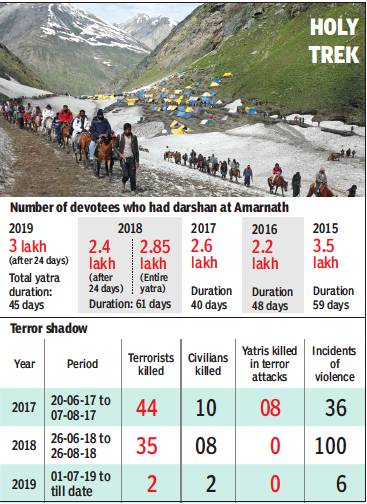Amarnath Yatra
This is a collection of articles archived for the excellence of their content. |
Contents |
Number of pilgrims
2015-19
Bharti Jain, July 26, 2019: The Times of India

The duration and dates of the Amarnath Yatra, 2015-19
From: Bharti Jain, July 26, 2019: The Times of India
Amarnath pilgrims set to shatter 2015 record
Over 3L Have Visited Shrine Till Now This Yr
New Delhi:
The number of Amarnath pilgrims who had ‘darshan’ at the holy cave in the 25 days since beginning of the annual yatra on July 1 this year, has already surpassed the figure for the entire duration of 61-day yatra last year. An impressive 3.01 lakh devotees have paid obeisance to the naturallyformed ice-shivalingam so far this year (between July 1 and July 24), against 2.4 lakh visitors in the corresponding period of 2018 and 2.85 lakh pilgrims during the entire Amarnath pilgrimage last year.
The latest cumulative figure of 3.01 lakh visitors to Amarnath shrine is the highest since 2016, with 2015 having witnessed 3.5 lakh ‘darshans’ over the 59-day pilgrimage. Incidentally, there are still three weeks to go before the current yatra ends on August 15. Not only has the Amarnath yatra been progressing peacefully, but there has also been a corresponding lull in terror-related activities in the Kashmir region. According to data accessed by TOI, between July 1 and July 24, just six violent incidents were recorded and two terrorists and civilians each, killed. During 2018 Amarnath Yatra that extended from June 26 to August 26, there were 100 violent incidents and 35 terrorists and eight civilians were killed, while the 2017 yatra from June 29 to August 7 recorded 36 incidents and fatal casualties to 44 terrorists and 10 civilians. Eight yatris were killed in a terror attack on a bus in 2017.
While the total number of darshans in the first 25 days of Amarnath yatra recorded a 25.51% increase as compared to corresponding period of 2018, what has been crucial to security and safety of the pilgrims is the 54.98% rise in the number of yatris travelling in registered convoys. Till July 24, 1.07 lakh yatris had come in registered convoys, as compared to just 69,164 yatris in the corresponding period of last year. The number of convoy vehicles too has seen an 80.98% rise to 4,349 till July 24 as compared to 2,403 in the first 25 days of 2018.
The heightened pilgrim traffic to Amarnath cave is seen as an outcome of tighter security arrangements put in place this year. The new security plan — which includes deployment of local police, 24x7 nakas, night area domination, use of technical aids like CCTVs and even satellite imagery, RFID tagging of vehicles and deployment of mountain rescue teams and SDRF teams on strategic locations — followed a comprehensive review of the yatra arrangements taken by home minister Amit Shah in J&K last month.
In addition to the deployment of central para-military forces and NDRF teams by the Modi government, the state government introduced QR-coding/bar-coding of yatra permit forms at access control gates and selective camps to track the movement of pilgrims in the yatra area.
The home ministry had recently informed the Lok Sabha that there had been no instance of stone pelting on Amarnath yatris this year.
NGT orders
Amarnath is not a 'silent zone', clarifies NGT
December 14, 2017: The Times of India
National Green Tribunal (NGT) has clarified that it is not declaring Amarnath a 'silent zone' and devotees have to maintain silence only in front of the idol. Previously, the NGT declared it a 'silent zone' and prohibited religious offerings beyond the entry point.
Reiterating its previous day's order, the Tribunal asked the devotees to maintain a single file from the base camp leading up to the shrine. It also clarified that its order was meant to preserve the sanctity of the shrine by minimizing damage caused to it by 'adverse noise'.
"These directions are to maintain sanctity of the cave and to ensure no adverse noise impact on shivling. Silence restrictions will not apply on Arti and other rituals", it said.
A bench headed by NGT chairperson Justice Swatanter Kumar had said the Amarnath Shrine Board should ensure that proper infrastructural facilities are provided to the pilgrims so that they are not deprived of a clear 'darshan', and the ecology of the area is maintained.
The NGT earlier said that declaring the area around the Amarnath cave shrine a 'silence zone' would be helpful in preventing avalanches and maintaining its pristine nature.
"Nobody would be permitted to carry anything from the stairs leading to the holy cave and everybody should be properly frisked at the entry point. From the point of stairs and the area inside the cave should be declared silence zone," the bench said.
The green panel ordered removal of iron grills in front of the ice stalagmite resembling the 'Shiva Linga' so that devotees could get a better view of it and said there should be no noise pollution near the sacred structure. It also restrained carrying of personal belongings including mobile phones beyond the last checkpoint and asked the shrine board to construct a place where pilgrims can keep their valuables.
The green panel also directed the committee of experts headed by an additional secretary of the Ministry of Environment and Forests (MoEF) to submit an action plan on providing facilities to the pilgrims within three weeks.
Environment activist Gauri Maulekhi, on whose plea the directions were passed, welcomed the NGT order and termed it "progressive".
"The Amarnath cave is located in a delicate ecosystem. The directions would make the Amarnath Yatra safe and convenient for the devotees. This would protect the shrine from degradation and ensure it is protected for the coming generations. It is indeed a very good and progressive direction," Maulekhi told PTI.